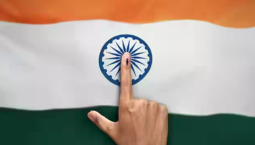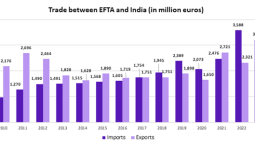India is one of the oldest civilizations in the world with a kaleidoscopic variety and rich cultural heritage. It has achieved all-round socio-economic progress during the last 70 years of its Independence. India has become self-sufficient in agricultural production and is now one of the top industrialized countries in the world and one of the few nations to have gone into outer space to conquer nature for the benefit of the people. It covers an area of 32,87,263 sq. km (1,269,346 sq mi), extending from the snow-covered Himalayan heights to the tropical rain forests of the south. As the 7th largest country in the world, India stands apart from the rest of Asia, marked off as it is by mountains and the sea, which give the country a distinct geographical entity. Bounded by the Great Himalayas in the north, it stretches southwards and at the Tropic of Cancer, tapers off into the Indian Ocean between the Bay of Bengal on the east and the Arabian Sea on the west.
India In Focus
Lying entirely in the northern hemisphere, the mainland extends between latitudes 8° 4′ and 37° 6′ north, longitudes 68° 7′ and 97° 25′ east and measures about 3,214 km from north to south between the extreme latitudes and about 2,933 km from east to west between the extreme longitudes. It has a land frontier of about 15,200 km. The total length of the coastline of the mainland, Lakshadweep Islands and Andaman & Nicobar Islands is 7,516.6 km.

Economic Profile
India’s gross domestic product (GDP) at current prices in the first quarter (Q1) of 2023-24 is estimated to be Rs. 70.67 trillion (~US$ 850 billion), as against Rs. 65.42 trillion (~US$ 829 billion) in Q1 of 2022-23, showing a growth rate of 8.0%.
Gross value added (GVA) quarterly estimates at basic prices for the first quarter (April-June) of 2023-24 at constant 2011-12 prices are as follows:
- Agriculture, forestry & fishing: Rs. 513,946 crore (US$ 61.80 billion).
- Mining & Quarrying: Rs. 87,587 crore (US$ 10.53 billion).
- Manufacturing: Rs. 667,770 crore (US$ 80.30 billion).
- Electricity, gas, water supply & other utility services: Rs. 92,704 crore (US$ 11.14 billion).
- Construction: Rs. 298,393 crore (US$ 35.88 billion).
- Trade, hotels, transport, communications & services related to broadcasting: Rs. 649,560 crore (US$ 78.11 billion).
- Financial, real estate & professional services: Rs. 989,293 crore (US$ 118.97 billion).
- Public administration, defence & other services: Rs. 474,678 crore (US$ 57.08 billion).
- Forex Reserves: US$ 586.90 billion, as of September 29, 2023.
- Value of Exports: India’s overall exports during April-September 2023 were estimated at US$ 376.29 billion. India’s overall exports in FY23 (April-March 2023) increased by 13.84% to US$ 770 billion.
- Export Partners: US, Germany, UAE, China, Japan, Thailand, Indonesia, and the EU. India is also tapping newer markets in Africa and Latin America.
- Currency (code): Indian rupee (Rs).
- Exchange Rates: Indian rupee per US$: US$ 1 = Rs. 83.15 as of October 25, 2023.
- Fiscal Year: April 01 – March 31.
- Cumulative FDI Equity Inflow: US$ 937.58 billion (from April 2000-June 2023).
- Share of the Top Investing Countries in FDI Equity Inflow: Mauritius (26%), Singapore (23%), the US (9%), Netherlands (7%), Japan (6%), the UK (5%), the UAE (2%), the Cayman Islands (2%), Germany (2%), and Cyprus (2%) from April 2000-June 2023.
- Key Sectors Attracting the Highest FDI Equity Inflow: Services Sector (16%), Computer Software & Hardware (15%), Trading (6%), Telecommunications (6%), Automobile (5%), Construction Activities (5%), Construction Development (4%), Drugs and Pharmaceuticals (3%), Chemicals (3%), and Metallurgical Industries (3%) from April 2000-June 2023.
Transportation In India
- Airports: The Airports Authority of India (AAI) manages a total of 137 airports, which include 24 international airports (3 civil enclaves), 10 customs airports (4 civil enclaves), and 103 domestic airports (23 civil enclaves) at defence airfields.
- International Airports: Ahmedabad, Amritsar, Bengaluru, Chennai, Goa, Guwahati, Hyderabad, Kochi, Kolkata, Mumbai, New Delhi, Thiruvananthapuram, Port Blair, Srinagar, Jaipur, Nagpur, Calicut.
- Railways: The Indian Railways network is spread over 126,366 km with 15,112 locomotives being operational. There are 13,1523 passenger trains and 9,146 freight trains run daily through 7,335 stations. The railway sector in India has loaded 1,512 million tonnes (MT) of freight during FY23, registering a 16.63% increase in freight loading from the last year. During April-August 2023, the Indian Railways carried 633.64 million tonnes of freight loading.
- Roadways: India’s road network of 6.37 million km is the second largest in the world. With the number of passenger vehicles growing at an average annual pace of 3.6% between 2010-20, Indian roads carry about 60% of freight and 87% of passenger traffic.
- Waterways: 14,500 km.
- Major Ports of Entry: Chennai, Ennore, Haldia, Jawaharlal Nehru Port Trust (JNPT), Kolkata, Deen Dayal, Kochi, Mormugao, Mumbai, New Mangalore, Paradip, Tuticorin, and Vishakhapatnam.













